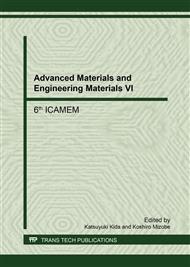p.358
p.363
p.369
p.375
p.381
p.386
p.391
p.396
p.403
High-Precision Determination of Residual Stress of As-Sprayed and Ground WC-10Co-4Cr Coating Using Optimized XRD-sin2ψ Technique
Abstract:
Thermally sprayed tungsten carbide-based coatings deposited by High Velocity Oxygen Fuel (HVOF) has been widely developed for its high corrosion and wear resistance. The finishing of the coated surface by grinding process is essential because of the high surface roughness of carbide coatings. Residual stresses existing in most hard coatings have significant influence on the adhesion, mechanical properties and tribological performance. The present study investigated the effect of grinding process on the residual stress of WC-10Co-4Cr coating by HVOF. The residual stress of coating was measured by the X-ray diffraction (XRD) technique using sin2ψ method. In addition, the effect of diffraction peak positioning method on the accuracy of residual stress of WC-10Co-4Cr coating was determined in the XRD technique. Four peak positioning methods and their effects on the accuracy of X-ray diffraction (XRD) residual stress measurement are considered. The results showed that the compressive residual stress of the WC-10Co-4Cr coating increase after grinding process. The parabolic method was selected for the peak positioning to measure the precise residual stress of HVOF-deposited WC-10Co-4Cr coating.
Info:
Periodical:
Pages:
381-385
Citation:
Online since:
August 2017
Authors:
Keywords:
Price:
Сopyright:
© 2017 Trans Tech Publications Ltd. All Rights Reserved
Share:
Citation:


